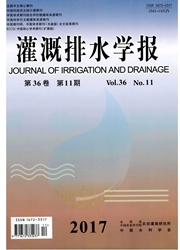

 中文摘要:
中文摘要:
N2O排放具有明显的水分效应,开展滴灌土壤水分空间分布对N_2O排放的影响规律研究,探索通过灌溉调控或调节土壤水分分布特征来减少温室气体排放具有十分重要的意义。通过土箱模拟点源入渗,采用静态暗箱-气相色谱法对不同水分分布条件下的土壤N_2O排放进行了取样测定和分析。结果表明,当土壤含水率低于田间持水率(壤土)的80%,土壤N_2O排放通量与土壤含水率成正相关关系;相同的土壤含水率条件下,垂向非均匀分布土壤N_2O排放通量高于垂向均匀分布,越接近田间持水率的80%差异越明显;土壤N_2O排放通量是随着土壤水分的再分布过程而动态变化的。通过调节土壤水分分布特征是可以达到降低土壤N_2O排放量的目的。
 英文摘要:
英文摘要:
N2O emissions have an apparent water effect. The effect of soil moisture spatial distribution on N2O emission under drip irrigation can help control and adjust the soil moisture distribution characteristics to reduce greenhouse gas emissions. Through point infiltration simulation of soil box, with the static opaque chamber and gas chromatography, N2O emission from soil were water content was lower than 80% of field water measured and analyzed. The results showed that when the soil holding capacity, the N2O emission and soil moisture content had a positive correlation; under the condition of the same soil water content, the N2O emission flux of vertical non-uniform distribution was higher than that of vertical uniform distribution. It was obviously different when the soil moisture content was close to 80% of field water holding capacity. N2O emission flux was dynamic change with the soil water redistribution process. By regulating the distribution of soil moisture could be achieved to re- duce the role of soil N2O emissions.
 同期刊论文项目
同期刊论文项目
 同项目期刊论文
同项目期刊论文
 期刊信息
期刊信息
